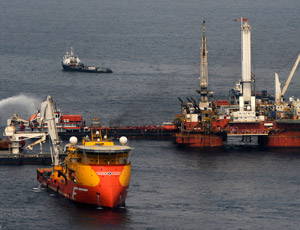Texas is preparing for the worst and hoping for the best, if the state’s shores suffer a “tarball” event.

The good news from the Texas General Land Office is that Texas is in better shape than its sister Gulf states because Texas’ sensitive marshes are behind barrier islands.
A darker outlook foresees a long-term cleanup project and years of litigation in the aftermath of the April 20 Deepwater Horizon rig explosion and oil spill. Some complain that the moratorium on new permits to drill will put many in a wait-and-see mode, and that the oil and gas industry suppliers based in Texas are at greater risk of economic loss than the state’s marine or tourism industries.
While most experts agree that Texas won’t suffer devastating affects of the spill, they point to the need for better prevention and more renewable energy sources. Most agree that any approach to containing and remediating spilt oil has a tradeoff.
Despite all the anger directed at BP, one expert says that the British company with U.S. headquarters in Houston is right to focus on source control and sealing the well. “They are taking the lead in these efforts, because they are the entity with the greatest know-how, compared to the federal government,” says Pedro Alvarez, chair of civil and environmental engineering at Rice University, Houston.
He admits, however, that the situation amounts to the “blind leading the blind.”
Texas Land Commissioner Jerry Patterson says that the Texas coast is clear for now, but he promises that if the spill reaches Texas shores, the Austin-based state agency will work with the U.S. Coast Guard and BP on the cleanup.
Jim Suydam, Texas General Land Office spokesman, says in the event of a major cleanup, Texas is in better shape than Louisiana “because it is protected by natural, continuous barrier islands that protect Texas’ wetlands, estuaries and marshes.”
Suydam says that if any oil does wash up on Texas’ beaches, “it will be so weathered by that time.” He says the chemical composition evaporates into lighter components, known as “tarballs.”
“There’s no rocket science to it,” Suydam says. The GLO says it will send out crews of day laborers with shovels to “pick up the tarballs,” which BP would pay for.
While tarballs still are seen on the Texas coast, the GLO says that there are fewer today than before the creation of the 1991 oil spill prevention and response program.
Nearly 1 million barrels of crude leaked into the Gulf due to natural seepage last year, according to the Petroleum Extension Service at the University of Austin at Texas.
This pales in comparison to the Deepwater Horizon spill, which Greg Pollock, deputy commissioner of the oil spill prevention response program for the GLO, calls “probably the most complicated and challenging event in U.S. history.” The GLO is coordinating with the Coast Guard to monitor daily trajectories.
Pollock says with or without the failed top-kill approach, the dangers are the same. “It would be impossible to characterize any response as good given the complexities,” he adds.

Post a comment to this article
Report Abusive Comment